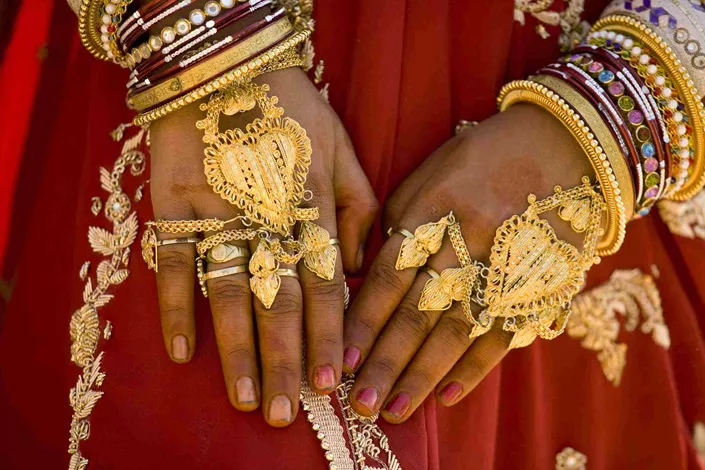Gold holds a special place in Indian culture, symbolizing wealth, purity, and prosperity. When purchasing gold, especially for jewelry or investment, understanding its purity is crucial. This article delves into what constitutes pure gold in India, how purity is measured, and the standards and certifications that ensure authenticity.
What Defines Pure Gold?
Pure gold, often referred to as 24-karat gold, is gold in its most unalloyed form, containing 99.9% gold. However, pure gold is inherently soft, making it less suitable for crafting durable jewelry. To enhance its strength and durability, gold is often alloyed with other metals such as silver, copper, or zinc. This alloying process affects the karatage and, consequently, the purity of the gold.
Measuring Gold Purity: Karats and Fineness
Gold purity is commonly measured in karats, with 24 karats representing pure gold. The karat system denotes the number of parts of gold out of a total of 24 parts. For example:
-
24K Gold: 24 parts gold (99.9% pure)
-
22K Gold: 22 parts gold and 2 parts other metals (91.6% pure)
-
18K Gold: 18 parts gold and 6 parts other metals (75% pure)
-
14K Gold: 14 parts gold and 10 parts other metals (58.5% pure)
Another measure of purity is fineness, which expresses gold content in parts per thousand. For instance:
-
999 Fineness: 99.9% pure gold (equivalent to 24K)
-
916 Fineness: 91.6% pure gold (equivalent to 22K)
-
750 Fineness: 75% pure gold (equivalent to 18K)
Understanding these measurements helps consumers make informed decisions when purchasing gold jewelry or artifacts.
The Role of Hallmarking in India
To protect consumers and ensure the authenticity of gold products, India has implemented a hallmarking system. Hallmarking is the accurate determination and official recording of the proportionate content of precious metals in items. In India, the Bureau of Indian Standards (BIS) oversees the hallmarking process.
Components of a BIS Hallmark
A BIS hallmark on gold jewelry consists of the following components:
-
BIS Logo: Indicates that the jewelry has been certified by the Bureau of Indian Standards.
-
Purity Mark: Denotes the purity of the gold in karats and fineness (e.g., 22K916 for 22-karat gold).
-
Assaying and Hallmarking Centre’s Mark: Identifies the BIS-certified center that tested and certified the item.
-
Jeweler’s Identification Mark: Represents the registered jeweler who manufactured or sold the item.
These markings provide consumers with confidence regarding the purity and authenticity of their gold purchases.
Mandatory Hallmarking Regulations
As of June 16, 2021, the Indian government has made hallmarking mandatory for gold jewelry and artifacts. This move aims to enhance transparency in the gold market and protect consumers from adulteration. Under these regulations:
-
Only registered jewelers are permitted to sell hallmarked gold jewelry.
-
Hallmarking is required for 14K, 18K, and 22K gold items.
-
Jewelry weighing less than 2 grams, as well as certain traditional jewelry styles like jadau, kundan, and polki, are exempt from mandatory hallmarking.
Non-compliance with these regulations can result in penalties, including fines and imprisonment, emphasizing the importance of adherence for jewelers.
Introduction of the Hallmark Unique Identification (HUID) Number
To further ensure the traceability and authenticity of hallmarked gold items, the BIS introduced the Hallmark Unique Identification (HUID) number. This six-digit alphanumeric code is unique to each piece of jewelry and can be used to verify its authenticity through the BIS Care App. The HUID system enhances consumer confidence by providing a transparent mechanism to trace the origin and certification details of gold items.
India’s Gold Reference Standard: Bharatiya Nirdeshak Dravya (BND-4201)
In a significant development, India introduced its own gold reference standard, known as Bharatiya Nirdeshak Dravya (BND-4201). Developed collaboratively by the India Government Mint, Bhabha Atomic Research Centre, National Centre for Compositional Characterisation of Materials, and the Council of Scientific & Industrial Research-National Physical Laboratory, BND-4201 serves as a benchmark for gold purity in the country. This standard aids in ensuring consistency and reliability in gold purity assessments across India.
Ensuring Purity When Purchasing Gold
When buying gold in India, consumers should take the following steps to ensure its purity:
-
Look for the BIS Hallmark: Ensure that the gold item bears the BIS hallmark, indicating it has been certified for purity.
-
Verify the Purity Mark: Check the karat and fineness markings to understand the gold content.
-
Identify the HUID Number: Use the unique identification number to verify the item’s authenticity through the BIS Care App.
-
Purchase from Reputable Jewelers: Buy gold from BIS-registered jewelers to ensure compliance with hallmarking regulations.
By following these guidelines, consumers can make informed decisions and safeguard themselves against purchasing substandard or adulterated gold products.
Conclusion
Understanding gold purity and the hallmarking system in India is essential for making informed purchases. The implementation of mandatory hallmarking, the introduction of the HUID system, and the establishment of the BND-4201 standard collectively enhance transparency and trust in the Indian gold market. As a consumer, being aware of these measures and diligently verifying gold purity can ensure that you receive value for your investment.
Related Topics:

